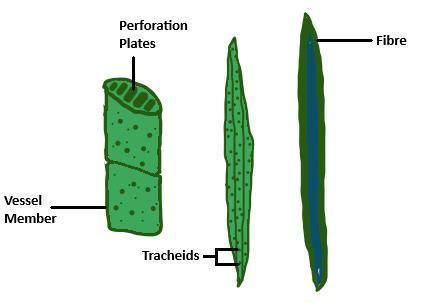
Tracheids differ from other tracheary elements in
A.Having Casparian strips.
B.Being imperforate
C.Lacking nucleus
D.Being lignified
Answer
470.7k+ views
Hint:The various tracheary elements are xylem vessels and tracheids. They are hollow and dead cell with its major function lying in nutrient and water transport through the plants.
Complete answer:Tracheids are imperforated in nature to retain the amount of sap inside for a longer time period since its major function is the ascent of sap, while xylem vessels are highly perforated. The tracheid cells have less efficiency in transportation since it is least perforated.

Figure: xylem vessel and tracheid
Considering other options:
The Casparian strip is a band made up of cell wall material present in the walls of the endodermis. It is made of lignin and suberin. It has a function in regulating the flow of water. It is present in all of the tracheary elements.
Since the tracheary elements are composed of dead cells throughout. These elements are devoid of the nucleus, both tracheids and xylem vessels do not contain a nucleus.
The thickened walls of the tracheary elements are due to the deposition of lignin. Both the elements possess lignin deposition in their cell walls, contributing to its rigidity.
Thus from the above-given option, the most appropriate one is B, that is only tracheids in the tracheary elements are imperforate, while vessels are perforated.
Note:There are two types of transport tissues in higher plants which are xylem and phloem. The major function of xylem tissues is the transportation of water and minerals from roots to the stem and leaves. The transport through xylem is predominantly unidirectional. It is found throughout the plant. On the other hand, the next type of transporting tissue is the phloem, which transports sugar or photosynthates from the photosynthetic tissues such as leaves to the non-food synthesizing tissues such as roots or developing flowers.
Complete answer:Tracheids are imperforated in nature to retain the amount of sap inside for a longer time period since its major function is the ascent of sap, while xylem vessels are highly perforated. The tracheid cells have less efficiency in transportation since it is least perforated.

Figure: xylem vessel and tracheid
Considering other options:
The Casparian strip is a band made up of cell wall material present in the walls of the endodermis. It is made of lignin and suberin. It has a function in regulating the flow of water. It is present in all of the tracheary elements.
Since the tracheary elements are composed of dead cells throughout. These elements are devoid of the nucleus, both tracheids and xylem vessels do not contain a nucleus.
The thickened walls of the tracheary elements are due to the deposition of lignin. Both the elements possess lignin deposition in their cell walls, contributing to its rigidity.
Thus from the above-given option, the most appropriate one is B, that is only tracheids in the tracheary elements are imperforate, while vessels are perforated.
Note:There are two types of transport tissues in higher plants which are xylem and phloem. The major function of xylem tissues is the transportation of water and minerals from roots to the stem and leaves. The transport through xylem is predominantly unidirectional. It is found throughout the plant. On the other hand, the next type of transporting tissue is the phloem, which transports sugar or photosynthates from the photosynthetic tissues such as leaves to the non-food synthesizing tissues such as roots or developing flowers.
Recently Updated Pages
Master Class 9 General Knowledge: Engaging Questions & Answers for Success

Master Class 9 English: Engaging Questions & Answers for Success

Master Class 9 Science: Engaging Questions & Answers for Success

Master Class 9 Social Science: Engaging Questions & Answers for Success

Master Class 9 Maths: Engaging Questions & Answers for Success

Class 9 Question and Answer - Your Ultimate Solutions Guide

Trending doubts
According to Bernoullis equation the expression which class 11 physics CBSE

A solution of a substance X is used for white washing class 11 chemistry CBSE

10 examples of friction in our daily life

Simon Commission came to India in A 1927 B 1928 C 1929 class 11 social science CBSE

Difference Between Prokaryotic Cells and Eukaryotic Cells

Can anyone list 10 advantages and disadvantages of friction




